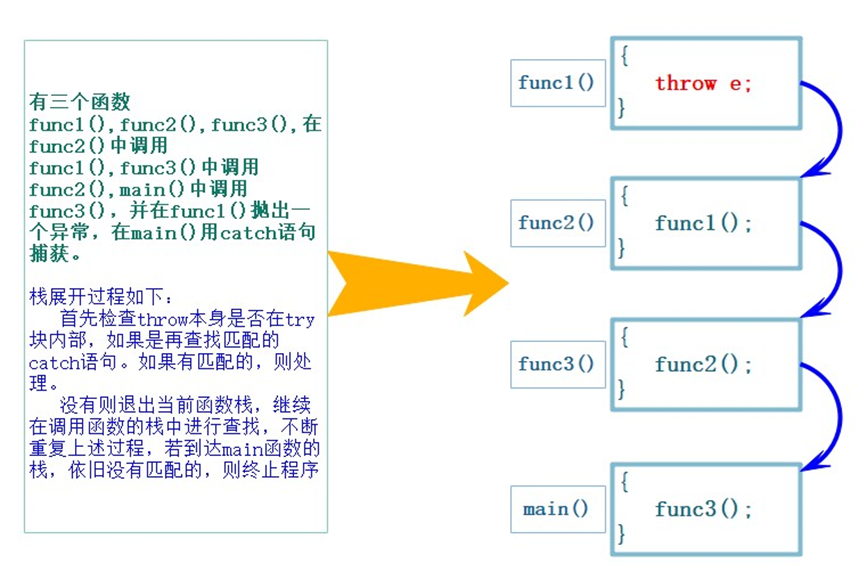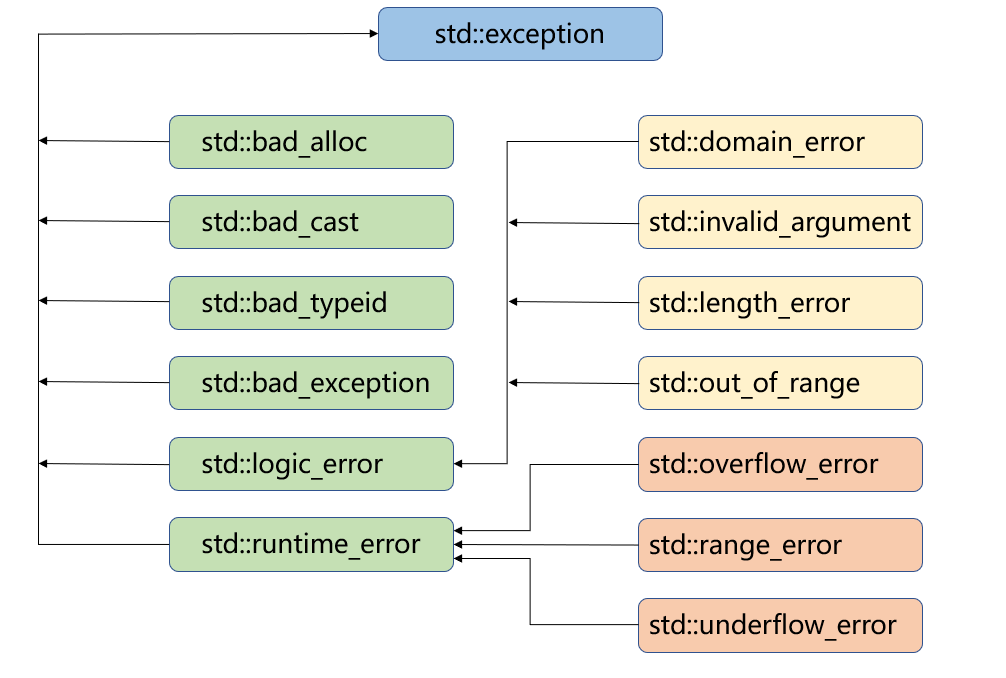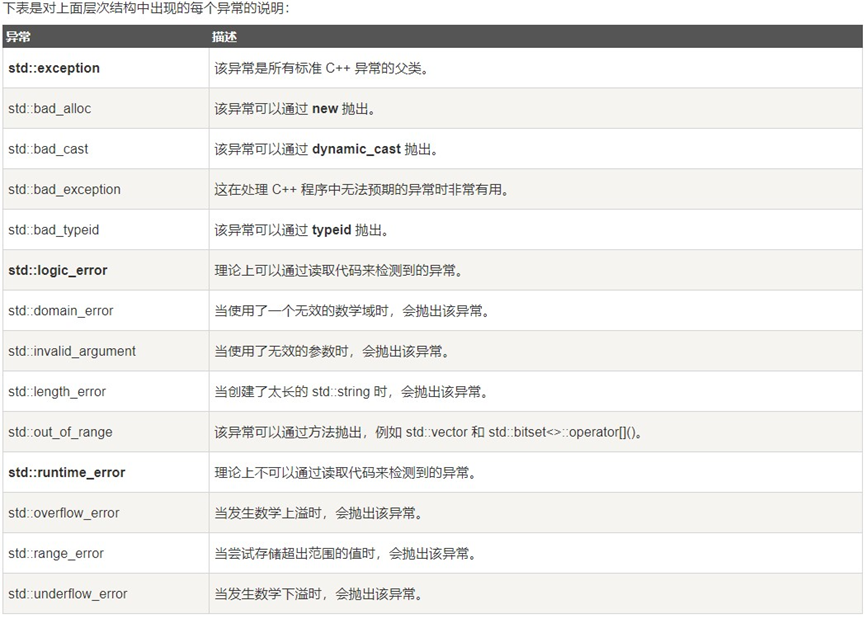-
<C++> 异常
C语言传统的处理错误的方式
传统的错误处理机制:
- 终止程序,如assert,缺陷:用户难以接受。如发生内存错误,除0错误时就会终止程序。
- 返回错误码,缺陷:需要程序员自己去查找对应的错误。如系统的很多库的接口函数都是通过把错误码放到errno中,表示错误
实际中C语言基本都是使用返回错误码的方式处理错误,部分情况下使用终止程序处理非常严重的错误。
C++异常概念
异常处理是C++提供的一种机制,用于处理程序运行过程中出现的异常情况。这种机制涉及到三个关键字:try、catch和throw。
- throw: 当程序中出现异常情况时,会使用throw关键字抛出一个异常。这是异常处理开始的地方。
- try: try是一个代码块,用于包含可能会抛出异常的代码。如果在try代码块中的代码抛出了异常,那么try代码块后面的代码将不会被执行,程序会直接跳到与之对应的catch代码块。
- catch: catch也是一个代码块,用于捕获和处理异常。catch代码块后面需要跟一个括号,括号中是异常的类型,这可以是一个已经存在的类型,也可以是程序员自定义的类型。
使用try/catch语句的语法如下所示:
try { //被保护的代码 } catch (ExceptionName e1) { //catch块 } catch (ExceptionName e2) { //catch块 } catch (ExceptionName eN) { //catch块 }- 1
- 2
- 3
- 4
- 5
- 6
- 7
- 8
- 9
异常的使用
异常的抛出和捕获
异常的抛出和匹配原则
-
异常是通过抛出对象而引发的,该对象的类型决定了应该激活哪个catch的处理代码。
-
被选中的处理代码是调用链中与该对象类型匹配且离抛出异常位置最近的那一个。
-
抛出异常对象后,会生成一个异常对象的拷贝,因为抛出的异常对象可能是一个临时对象,所以会生成一个拷贝对象,这个拷贝的临时对象会在被catch以后销毁。(这里的处理类似于函数的传值返回)
-
catch(...)可以捕获任意类型的异常,问题是不知道异常错误是什么。 -
实际中抛出和捕获的匹配原则有个例外,并不都是类型完全匹配,可以抛出的派生类对象,使用基类捕获,这个在实际中非常实用,我们后面会详细讲解这个。
在函数调用链中异常栈展开匹配原则
- 首先检查throw本身是否在try块内部,如果是再查找匹配的catch语句。如果有匹配的,则调到catch的地方进行处理。
- 没有匹配的catch则退出当前函数栈,继续在调用函数的栈中进行查找匹配的catch。
- 如果到达main函数的栈,依旧没有匹配的,则终止程序。上述这个沿着调用链查找匹配的catch子句的过程称为栈展开。所以实际中我们最后都要加一个catch(…)捕获任意类型的异常,否则当有异常没捕获,程序就会直接终止。
- 找到匹配的catch子句并处理以后,会继续沿着catch子句后面继续执行。
比如下面的代码中main函数中调用了func3,func3中调用了func2,func2中调用了func1,在func1中抛出了一个string类型的异常对象。
#include#include using namespace std; void func1() { throw string("这是一个异常"); } void func2() { func1(); } void func3() { func2(); } int main() { try { func3(); } catch (const string &s) { cout << "错误描述:" << s << endl; } catch (...) { cout << "未知异常" << endl; } return 0; } - 1
- 2
- 3
- 4
- 5
- 6
- 7
- 8
- 9
- 10
- 11
- 12
- 13
- 14
- 15
- 16
- 17
- 18
- 19
- 20
- 21
- 22
- 23
- 24
- 25
当func1中的异常被抛出后:
- 首先会检查throw本身是否在try块内部,这里由于throw不在try块内部,因此会退出func1所在的函数栈,继续在上一个调用函数栈中进行查找,即func2所在的函数栈。
- 由于func2中也没有匹配的catch,因此会继续在上一个调用函数栈中进行查找,即func3所在的函数栈。
- func3中也没有匹配的catch,于是就会在main所在的函数栈中进行查找,最终在main函数栈中找到了匹配的catch。
- 这时就会跳到main函数中对应的catch块中执行对应的代码块,执行完后继续执行该代码块后续的代码。
如下图所示:

上述这个沿着调用链查找匹配的catch子句的过程称为栈展开。在实际中我们最后都要加一个
catch(...)捕获任意类型的异常,否则当有异常没捕获时,程序就会直接终止。#includeusing namespace std; double Division(int a, int b) { // 当b == 0时抛出异常 if (b == 0) throw "Division by zero condition!"; else return ((double)a / (double)b); } void Func() { int len, time; cin >> len >> time; cout << Division(len, time) << endl; } int main() { try { Func(); } catch (const char* errmsg) { cout << errmsg << endl; } catch (...) { cout << "unkown exception" << endl; } return 0; } - 1
- 2
- 3
- 4
- 5
- 6
- 7
- 8
- 9
- 10
- 11
- 12
- 13
- 14
- 15
- 16
- 17
- 18
- 19
- 20
- 21
- 22
- 23
- 24
- 25
- 26
- 27
- 28
输出:
10 0 Division by zero condition!- 1
- 2
如果throw没有匹配的catch
int main() { try { Func(); } catch (int errmsg) { cout << errmsg << endl; } return 0; }- 1
- 2
- 3
- 4
- 5
- 6
- 7
- 8
- 9
- 10

只有加上
catch (...)int main() { try { Func(); } catch (int errmsg) { cout << errmsg << endl; } catch (...) { cout << "unkown exception" << endl; } return 0; }- 1
- 2
- 3
- 4
- 5
- 6
- 7
- 8
- 9
- 10
- 11
- 12
- 13
输出:
10 0 unkown exception- 1
- 2
异常的重新抛出
有时候单个的catch可能不能完全处理一个异常,在进行一些校正处理以后,希望再交给更外层的调用链函数来处理,比如最外层可能需要拿到异常进行日志信息的记录,这时就需要通过重新抛出将异常传递给更上层的函数进行处理。
但如果直接让最外层捕获异常进行处理可能会引发一些问题。比如:
#include#include using namespace std; void func1() { throw string("这是一个异常"); } void func2() { int *array = new int[10]; func1(); //do something... delete[] array; } int main() { try { func2(); } catch (const string &s) { cout << s << endl; } catch (...) { cout << "未知异常" << endl; } return 0; } - 1
- 2
- 3
- 4
- 5
- 6
- 7
- 8
- 9
- 10
- 11
- 12
- 13
- 14
- 15
- 16
- 17
- 18
- 19
- 20
- 21
- 22
- 23
- 24
- 25
- 26
- 27
其中func2中通过new操作符申请了一块内存空间,并且在func2最后通过delete对该空间进行了释放,但由于func2中途调用的func1内部抛出了一个异常,这时会直接跳转到main函数中的catch块执行对应的异常处理程序,并且在处理完后继续沿着catch块往后执行。
这时就导致func2中申请的内存块没有得到释放,造成了内存泄露。这时可以在func2中先对func1抛出的异常进行捕获,捕获后先将申请到的内存释放再将异常重新抛出,这时就避免了内存泄露。比如:
#include#include using namespace std; void func1() { throw string("这是一个异常"); } void func2() { int* array = new int[10]; try { func1(); //do something... } catch (...) { delete[] array; throw; //捕获func1的异常,将捕获到的异常再次重新抛出 } delete[] array; } int main() { try { func2(); } catch (const string& s) { cout << s << endl; } catch (...) { cout << "未知异常" << endl; } return 0; } - 1
- 2
- 3
- 4
- 5
- 6
- 7
- 8
- 9
- 10
- 11
- 12
- 13
- 14
- 15
- 16
- 17
- 18
- 19
- 20
- 21
- 22
- 23
- 24
- 25
- 26
- 27
- 28
- 29
- 30
- 31
- 32
- 33
- 34
说明一下:
- func2中的new和delete之间可能还会抛出其他类型的异常,因此在fun2中最好以catch(…)的方式进行捕获,将申请到的内存delete后再通过throw重新抛出。
- 重新抛出异常对象时,throw后面可以不用指明要抛出的异常对象(正好也不知道以catch(…)的方式捕获到的具体是什么异常对象)。
异常安全
将抛异常导致的安全问题叫做异常安全问题,对于异常安全问题下面给出几点建议:
- 构造函数完成对象的构造和初始化,最好不要在构造函数中抛出异常,否则可能导致对象不完整或没有完全初始化。
- 析构函数主要完成对象资源的清理,最好不要在析构函数中抛出异常,否则可能导致资源泄露(内存泄露、句柄未关闭等)。
- C++中异常经常会导致资源泄露的问题,比如在new和delete中抛出异常,导致内存泄露,在lock和unlock之间抛出异常导致死锁,C++经常使用RAII的方式来解决以上问题。
异常规范
在C++中,异常规范是一种语法,用于显式地声明一个函数可能抛出的异常类型。异常规范在函数声明后面,使用 throw 关键字后跟括号内可能抛出的异常类型列表来表示。
- 在函数的后面接
throw(type1, type2, ...),列出这个函数可能抛掷的所有异常类型。 - 在函数的后面接
throw()或noexcept(C++11),表示该函数不抛异常。 - 若无异常接口声明,则此函数可以抛掷任何类型的异常。(异常接口声明不是强制的)
例如:
void func() throw (int, char); // 可抛出 int 或 char 类型的异常- 1
C++11以后的新标准已经废弃了上述的异常规范方式,取而代之的是
noexcept关键字。noexcept用于声明一个函数保证不抛出任何异常。如果函数确实抛出了异常,那么程序将调用 std::terminate(),引发程序的终止。例如:
void func() noexcept; // 声明 func() 保证不抛出任何异常- 1
另外,
noexcept还可以带一个可选的布尔参数,如果参数为 true,那么表示函数保证不抛出任何异常,等同于无参数的noexcept;如果参数为 false,那么表示函数可能抛出异常。例如:
void func() noexcept(true); // 声明 func() 保证不抛出任何异常 void func() noexcept(false); // 声明 func() 可能抛出异常- 1
- 2
使用
noexcept能帮助编译器进行一些优化,因此在知道函数不会抛出异常的情况下,建议使用noexcept。自定义异常体系
实际中很多公司都会自定义自己的异常体系进行规范的异常管理。
- 公司中的项目一般会进行模块划分,让不同的程序员或小组完成不同的模块,如果不对抛异常这件事进行规范,那么负责最外层捕获异常的程序员就非常难受了,因为他需要捕获大家抛出的各种类型的异常对象。
- 因此实际中都会定义一套继承的规范体系,先定义一个最基础的异常类,所有人抛出的异常对象都必须是继承于该异常类的派生类对象,因为异常语法规定可以用基类捕获抛出的派生类对象,因此最外层就只需捕获基类就行了。
如下图:

服务器开发中通常使用的异常继承体系:
#include// for std::chrono::seconds #include // for srand, rand #include // for time #include #include #include // for std::this_thread::sleep_for using namespace std; class Exception { public: Exception(const string &errmsg, int id) : _errmsg(errmsg), _id(id) {} virtual string what() const { return _errmsg; } protected: string _errmsg; int _id; }; class SqlException : public Exception { public: SqlException(const string &errmsg, int id, const string &sql) : Exception(errmsg, id), _sql(sql) {} virtual string what() const { string str = "SqlException:"; str += _errmsg; str += "->"; str += _sql; return str; } private: const string _sql; }; class CacheException : public Exception { public: CacheException(const string &errmsg, int id) : Exception(errmsg, id) {} virtual string what() const { string str = "CacheException:"; str += _errmsg; return str; } }; class HttpServerException : public Exception { public: HttpServerException(const string &errmsg, int id, const string &type) : Exception(errmsg, id), _type(type) {} virtual string what() const { string str = "HttpServerException:"; str += _type; str += ":"; str += _errmsg; return str; } private: const string _type; }; void SQLMgr() { srand(time(0)); if (rand() % 7 == 0) { throw SqlException("权限不足", 100, "select * from name = '张三'"); } //throw "xxxxxx"; } void CacheMgr() { srand(time(0)); if (rand() % 5 == 0) { throw CacheException("权限不足", 100); } else if (rand() % 6 == 0) { throw CacheException("数据不存在", 101); } SQLMgr(); } void HttpServer() { // ... srand(time(0)); if (rand() % 3 == 0) { throw HttpServerException("请求资源不存在", 100, "get"); } else if (rand() % 4 == 0) { throw HttpServerException("权限不足", 101, "post"); } CacheMgr(); } int main() { while (1) { this_thread::sleep_for(chrono::seconds(1)); try { HttpServer(); } catch (const Exception &e)// 这里捕获父类对象就可以 { // 多态 cout << e.what() << endl; } catch (...) { cout << "Unkown Exception" << endl; } } return 0; } - 1
- 2
- 3
- 4
- 5
- 6
- 7
- 8
- 9
- 10
- 11
- 12
- 13
- 14
- 15
- 16
- 17
- 18
- 19
- 20
- 21
- 22
- 23
- 24
- 25
- 26
- 27
- 28
- 29
- 30
- 31
- 32
- 33
- 34
- 35
- 36
- 37
- 38
- 39
- 40
- 41
- 42
- 43
- 44
- 45
- 46
- 47
- 48
- 49
- 50
- 51
- 52
- 53
- 54
- 55
- 56
- 57
- 58
- 59
- 60
- 61
- 62
- 63
- 64
- 65
- 66
- 67
- 68
- 69
- 70
- 71
- 72
- 73
- 74
- 75
- 76
- 77
- 78
- 79
- 80
- 81
- 82
- 83
- 84
- 85
- 86
- 87
- 88
- 89
- 90
- 91
- 92
- 93
- 94
- 95
- 96
- 97
- 98
- 99
- 100
- 101
- 102
- 103
- 104
- 105
- 106
- 107
说明一下:
- 异常类的成员变量不能设置为私有,因为私有成员在子类中是不可见的。
- 基类Exception中的what成员函数最好定义为虚函数,方便子类对其进行重写,从而达到多态的效果。
C++标准库的异常体系
C++标准库当中的异常也是一个基础体系,其中exception就是各个异常类的基类,我们可以在程序中使用这些标准的异常,它们之间的继承关系如下:

下表是对上面继承体系中出现的每个异常的说明:

说明一下:
- exception类的what成员函数和析构函数都定义成了虚函数,方便子类对其进行重写,从而达到多态的效果。
- 实际中我们也可以去继承exception类来实现自己的异常类,但实际中很多公司都会自己定义一套异常继承体系。因为C++标准库设计的不够好用。
异常的优缺点
优点:
- 信息丰富:异常对象可以携带丰富的信息,包括错误类型、详细描述、堆栈调用信息等,这在错误定位和bug调试时非常有帮助。
- 错误传播:异常允许错误信息沿着函数调用链条向上层传递,直到被捕获和处理。这样就避免了需要在每一层都进行错误检查和处理的繁琐。
- 兼容性:许多第三方库都使用异常处理来处理错误,使用异常能够更好地调用这些库的功能。
- 方便测试:许多测试框架也支持异常处理,使用异常可以更容易地进行单元测试和白盒测试。
- 某些情况下必要:对于某些无法通过返回值表示错误的情况,,比如
T& operator这样的函数,如果pos越界了只能使用异常或者终止程序处理,没办法通过返回值表示错误。
缺点:
- 控制流混乱:异常会导致程序的执行流程发生跳转,这可能会使得程序的控制流程变得混乱,给代码阅读、调试和维护带来困扰。
- 性能开销:虽然现代硬件性能较高,但异常处理仍然会引入一些性能开销,当异常频繁发生时,性能影响可能会显著。
- 可能导致资源泄漏:在C++中,资源管理需要程序员手动完成。由于异常可能导致函数提前退出,因此可能会导致资源泄露。要解决这个问题,需要使用RAII(资源获取即初始化)等技术,这会增加学习和使用的复杂性。
- 异常体系混乱:由于C++标准库的异常体系设计不够完善,很多时候开发者需要自定义异常,这可能导致异常类型混乱,增加了使用的难度。
- 方便测试:许多测试框架也支持异常处理,使用异常可以更容易地进行单元测试和白盒测试。
- 某些情况下必要:对于某些无法通过返回值表示错误的情况,,比如
T& operator这样的函数,如果pos越界了只能使用异常或者终止程序处理,没办法通过返回值表示错误。
-
相关阅读:
MySQL高可用搭建方案之(MMM)
java对象的内存布局
非关系型数据库-Redis
VXLAN详解
【Linux】进程信号(学习复习兼顾)
[含毕业设计论文+PPT+源码等]ssm后勤服务|会议室预约|办公管理管理系统小程序+Java后台管理系统|前后分离VUE
基于nginx的tomcat负载均衡和集群(超简单)
关于加密解密有哪些你需要知道知识?一篇文章告诉你
论文阅读笔记——基于CNN-GAP可解释性模型的软件源码漏洞检测方法
Redis常用数据结构详解
- 原文地址:https://blog.csdn.net/ikun66666/article/details/133554549
